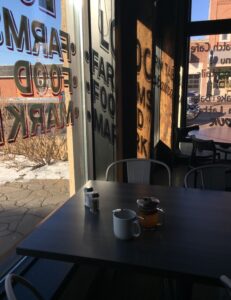Bronx Peacocks and Mornings At Farm Table
The mornings were steamy when I stepped out of the elevated train an onto the platform. I’d hurry down to street level and walk to the front gate of the Bronx Zoo, a jungle oasis in the middle of New York City. As the train rumbled away, I couldn’t help but think of the dozens of commuters I’d left behind, their noses buried in newspapers or eyes shut for one last catnap. They were in for another day of phone calls, meetings and office pressures. My day would be different.
I’d shoulder through the iron gate, moving from city sidewalk to tree-lined paths. Birds called above me and the occasional peacock slowly strutted on a gravel walk. The air was fresh, the winding paths brushed clean. It was quiet. The busloads of kids were still a couple of hours off. Mornings at the zoo were a paradise. I just breathed it in.
 I was a 17-year old volunteer at the zoo hospital. My dream of being a vet started when I was about eight, and that summer I helped Hanna, a student vet, with her research into anesthesia for snakes. The head vet was a fairly young man with a foot in a cast, I can’t remember why. We were in a building nobody noticed doing work almost no one thought about. The cages — our patients — were breeds from all around the world. We were the back room to an unusual business — a zoo — and I was in heaven.
I was a 17-year old volunteer at the zoo hospital. My dream of being a vet started when I was about eight, and that summer I helped Hanna, a student vet, with her research into anesthesia for snakes. The head vet was a fairly young man with a foot in a cast, I can’t remember why. We were in a building nobody noticed doing work almost no one thought about. The cages — our patients — were breeds from all around the world. We were the back room to an unusual business — a zoo — and I was in heaven.
That was a generation, and many dreams, ago.
Today, I again find myself in a place where I’m usually the first to open the door and turn up the thermostat. It’s quiet and still in the early hours. Sunlight slants through a wide bank of floor-to-ceiling windows that give a panoramic view of downtown. I walk among the restaurant tables and chairs, check the doors, review the retail space. Every day I get a glimpse into an industry most of us enjoy, but few see from the inside.
 I sometimes make myself a small pot of tea and carry it to my tiny office at the back of our building. My laptop helps me monitor the financial picture of this adventerous nonprofit — a foundation with a restaurant as its major program. Our mission is to build local food culture by purchasing ingredients – whole foods – from sustainable farms. It’s something that’s rarely done anywhere. It requires maintaining a large number of relationships, paying the cost for real food, and taking the time to prepare meals using whole foods. Most restaurants order nearly all their ingredients — usually sliced, diced, prepped and bagged — through one or two distributors. Not so here.
I sometimes make myself a small pot of tea and carry it to my tiny office at the back of our building. My laptop helps me monitor the financial picture of this adventerous nonprofit — a foundation with a restaurant as its major program. Our mission is to build local food culture by purchasing ingredients – whole foods – from sustainable farms. It’s something that’s rarely done anywhere. It requires maintaining a large number of relationships, paying the cost for real food, and taking the time to prepare meals using whole foods. Most restaurants order nearly all their ingredients — usually sliced, diced, prepped and bagged — through one or two distributors. Not so here.
Two or three times a day, a jangling burst of music gets me on my feet to welcome a vendor at the service door. Sometimes it’ll be boxes of potatoes and deep orange carrots, tightly packed brussel sprouts, large cartons filled with dozens of fresh eggs, beets or squash. Then there are days when fresh butter, spices, herbs, and cheeses make their way into the freezers, chillers and storage shelves. Being a beef farmer myself, I’m familiar with nearly every local grower selling to Farm Table. They are a vital part of our community. They also play a critical role in restoring our local environment while growing highly nutritious foods.
It’s amazing that I can drive from my farm home, down a short road and sit at a laptop within a restaurant that consistantly delivers menus rivaling any in major metropolitan areas.
Yes, I’m lucky. I’m warmed by the early morning rays that bathe the dining area. And I get to enjoy the smiles and company of the guests who come through our doors for lunch, brunch, or a Farm Table experience.
I hope to greet you here soon.
Sylvia
